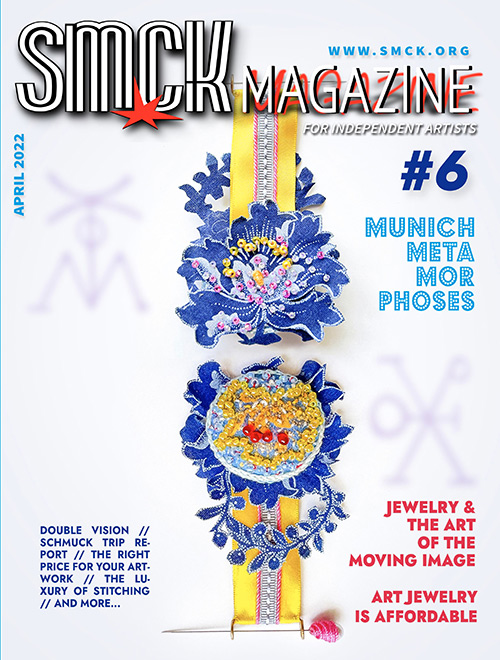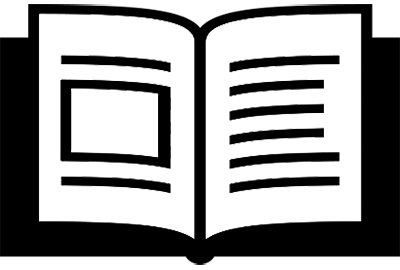EXPAND OVER THE LIMITS
HAE WON KOO MAKES KOREAN ART JEWELRY INTERNATIONALLY ACCLAIMED
Interview by Christoph Ziegler
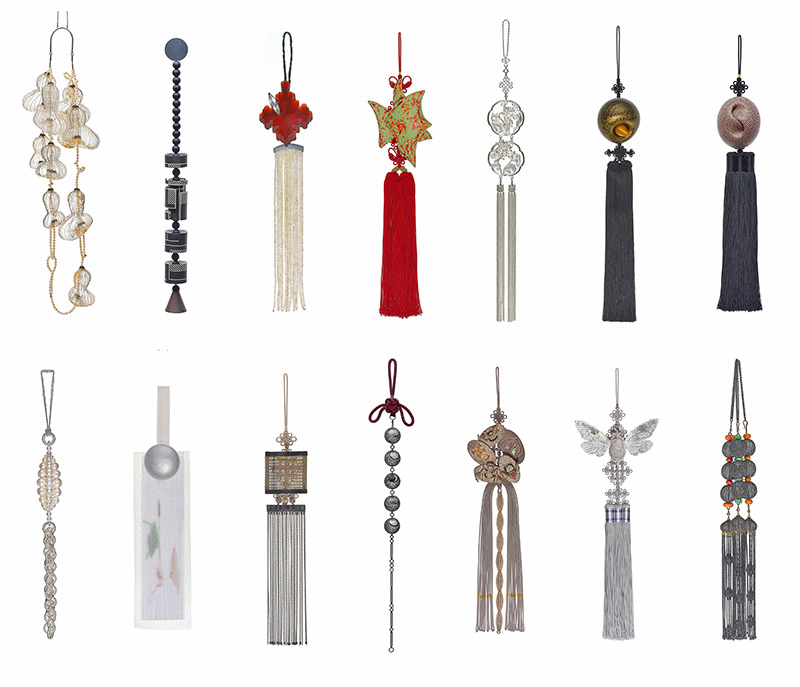 Korean traditional Norigae reinterpreted in contemporary terms by 14 jewellery artists. Photo: Junghoon Oh / Munch Studio.
Korean traditional Norigae reinterpreted in contemporary terms by 14 jewellery artists. Photo: Junghoon Oh / Munch Studio.
Although Hae Won Koo's main occupation is in the financial sector, she always had a great passion for all the arts. She fell in love with art jewelry about fifteen years ago through her friend Jung Hoo Kim, one of the first-generation art jewelry artists in Korea. Ever since, Hae Won Koo has been supporting artists, not just by collecting artworks, but also through curating and mentoring.
Pureun Culture Foundation, founded in 2016, discovers and supports talented artists to promote Korean art and culture to the world and thus increase the country's international prestige. The foundation also supports cultural and art organizations to create a more prosperous society.
CZ: What is the social role of jewelry in Korean cultural tradition?
HWK: Koreans always liked to adorn themselves regardless of gender and social class. Although during Joseon Dynasty (14th-19th c.), Korea's latest dynasty, jewelry was simple due to restrictions, people still found different ways to adorn themselves. Clothing ornaments like Norigae were developed and worn by women of all classes. Many of the ornaments symbolized women's marital status. Garakji, a set of two rings, was only worn by married women, while women could wear Binyeo only after their coming-of-age ceremony.
In the last exhibition I curated, I wanted to "marry" Korea's unique traditional jewelry with contemporary works and liberate it from restricted traditional forms and meanings.
CZ: You recently curated two exhibitions in Seoul, Absolutely Abstract (2020) in Lee Eugean Gallery and Yeonliji: Two Becoming One (2021) in the Arumjigi Culture Keepers Foundation. The two exhibitions represented 50 Korean jewelry artists, designers, and crafters. What are the characteristics of contemporary Korean crafts, especially jewelry?
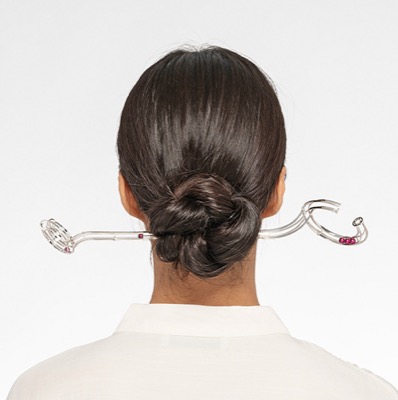
"Hair Ornament No.03" - Rolling Series by Junsuk Min, 2021. Photo: Junghoon Oh / Munch Studio.
HWK: I think the top characteristics of Korean crafts are dexterity and paying attention to details. As Korea is the only country in Asia to use metal chopsticks, we were known to have great hand-working skills. Artists have been exploring new materials like silicone, paper, fabric, horsehair, intestines, etc. They have expanded the conceptual and philosophical approach to crafts.
Korean art jewelry is, however, still very underrated. The lack of public leads to lack of sales, and this reality makes art jewelry less interesting for students. Few study jewelry and metals. Many undergraduates change their majors to graphic or industrial design, which are "safer" for finding a job.
CZ: Worldwide, we are currently witnessing significant economic, ecological, and political changes. How do traditional values and aesthetics such as "harmony" and "balance" correspond with the present-day situation?
HWK: We are currently witnessing significant changes in society, and conflicts are prevalent. Harmony and balance are found when one faces the conflicts rather than ignoring them or running away.
In the exhibition Yeonliji: Two Becoming One, I chose the theme as Yeonliji (inosculation), a phenomenon when the trunks or branches of two distinct trees grow together. I wanted to show harmony and balance between two contrasting elements such as man vs woman, ordinary day vs special day like wedding, and traditional vs contemporary. Moreover, I hope to see an understanding society that embraces differences, just like how the Yeonliji trees grow to become one while keeping their own roots.
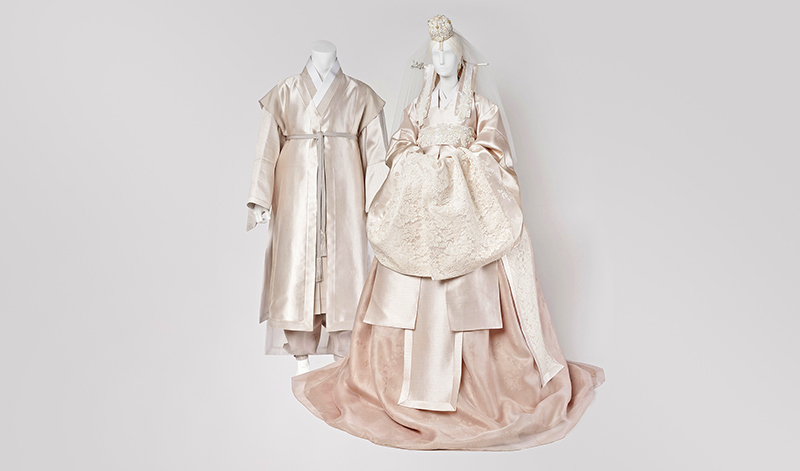 "The Pearl Hwarot" - Korean traditional wedding costume by Mihee Bae (The Dan), 2021. Photo: Junghoon Oh / Munch Studio.
"The Pearl Hwarot" - Korean traditional wedding costume by Mihee Bae (The Dan), 2021. Photo: Junghoon Oh / Munch Studio.
CZ: Pureun Culture Foundation sponsors shows and promotes Korean artists and designers. How do you make the public aware of Korea's contemporary art and design?
HWK: In the beginning, I only focused on promoting art jewelry to the Korean public. Last year Purueun Culture Foundation started to address the international scene. This year we are collaborating with Siat Gallery, a pop-up project-based gallery located in both Paris and Seoul.
Jeannie Lee, the director of Siat Gallery, studied Jewelry and Metals at Rhode Island School of Design in USA and is interested in crafts. She already had international experience that can be helpful for my project, and I have valuable insights I can offer, so a great synergy to promote art jewelry can be anticipated.
We are a very small foundation with a small budget. We never try to promote the foundation or put ourselves before the artists. However, we started to feel the need to be more active in online communication.
CZ: What are the art and design disciplines Pureun Culture Foundation supports?
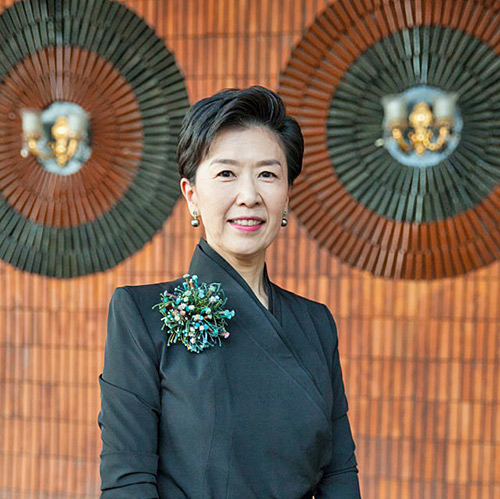
Hae Won Koo at KBS hall, Seoul. Photo: unknown.
HWK: We try our best to not be swayed by the artists' backgrounds and solely focus on the work regardless of discipline.
I also believe that a successful exhibition is not only the result of showing good artists, but also of having a solid theme and the right directing. Since 2018, I have invited 20-30 different participants from art jewelry, other crafts, and related fields to participate in exhibitions of specific themes.
We try to acquire five to six artworks every year, including art jewelry, and choose works that can inspire other artists, students, and the public. My philosophy is, among other principles, to collect something that creates a powerful spark in me, even if it's not wearable or practical. Society has become more focused on fast fashion and practicality, limiting artists to make sellable work.
CZ: How do you envision the future of jewelry after two years of lockdowns?
HWK: I feel that the two years of lockdowns and social distancing has caused a big crisis in the jewelry sector. However I believe and hope that after this pandemic is over, the desire to adorn oneself will explode, and people will find more occasions to wear jewelry in public.
This crisis can also be a turning point for some artists in pushing the limits of their artistic abilities and career. Maybe jewelry can also expand to virtual art and NFTs.
Instagram:
thekooexhibition







